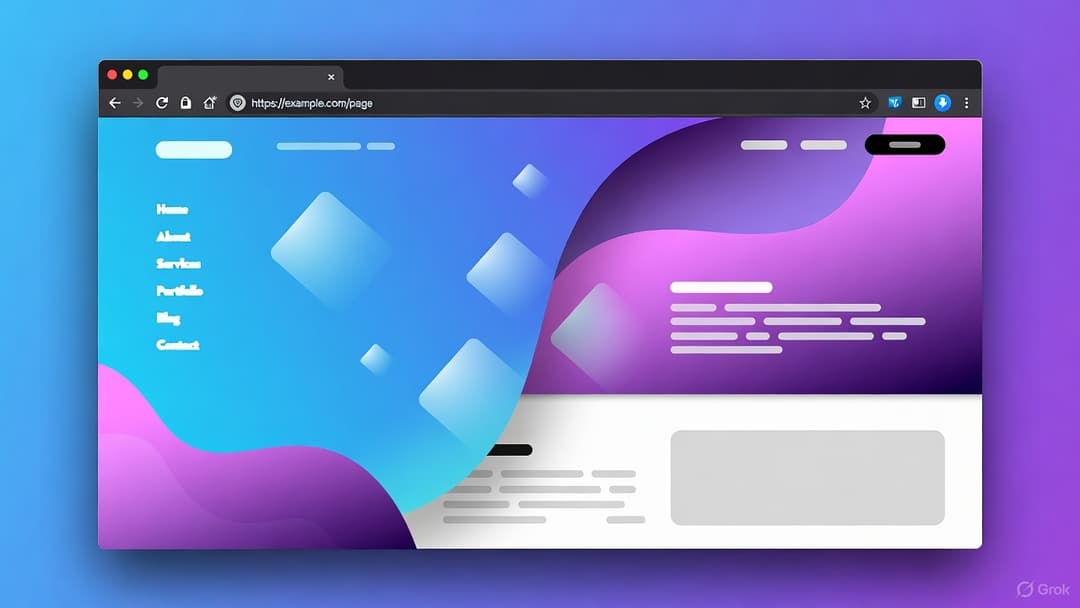
Mastering the View Transitions API — Native Page Animations for Modern SPAs
By Ghazi Khan | Oct 30, 2025 - 5 min read
Animations are no longer just a design aesthetic — they’re a performance tool.
If done right, they can make your Single Page App (SPA) feel instant and fluid.
And now, with Chrome 129 and Firefox 130, you can finally do it natively using the View Transitions API — no extra libraries, no heavy reflows.
Let’s break down what it is, how it works, and how you can use it right now in your React, Vue, or Svelte project.
🧠 What Is the View Transitions API?
The View Transitions API is a browser-native way to animate between two DOM states.
Instead of manually handling opacity, transform, or re-render delays, the browser captures the before and after states of your UI and smoothly transitions between them.
Think of it like a built-in motion system for your app.
It handles:
- Element position and opacity changes
- Route or page transitions
- Layout shifts after DOM mutations
Supported now in:
- ✅ Chrome 129+
- ✅ Firefox 130+
- ⚙️ Safari — behind experimental flag
⚡ Why It Matters
Until now, developers faked transitions with:
- Heavy JavaScript animation libraries
framer-motionorGSAPwith hydration delays- CSS transitions that broke when the DOM changed
The View Transitions API changes that.
It gives you layout-aware animations without repaint chaos — all done by the browser compositor for better FPS and power efficiency.
Performance gains:
- 60 FPS guaranteed animations
- Reduced layout shift (improves CLS)
- Zero dependency cost
In short: this is how the web catches up to native app smoothness.
🧩 Basic Usage
Let’s start simple — animating a layout change.
document.startViewTransition(() => {
document.querySelector('.box').classList.toggle('expanded');
});
Here’s what’s happening:
- The browser takes a snapshot of the current DOM (pre-transition).
- The callback runs — your DOM mutates.
- The browser animates from the old snapshot to the new layout automatically.
With CSS, you can control how it animates:
::view-transition-old(box),
::view-transition-new(box) {
transition: transform 0.6s ease, opacity 0.3s;
}
Yes, those pseudo-elements ::view-transition-old and ::view-transition-new are part of the new spec — and they make animating between states ridiculously easy.
⚛️ Using It in React
React doesn’t know the browser is about to change the DOM, so we wrap the mutation in the transition call:
function ThemeToggle() {
const [dark, setDark] = useState(false);
const toggleTheme = () => {
document.startViewTransition(() => {
setDark((prev) => !prev);
document.documentElement.classList.toggle('dark');
});
};
return (
<button onClick={toggleTheme}>
Switch to {dark ? 'Light' : 'Dark'} Mode
</button>
);
}
Result → smooth dark/light mode transitions with zero flicker. And because this runs natively, it doesn’t break React’s reconciliation or re-render cycle.
🔷 Using It in Vue or Svelte
Vue Example:
<template>
<button @click="toggle">Toggle Box</button>
<div class="box" :class="{ active }"></div>
</template>
<script setup>
import { ref } from 'vue';
const active = ref(false);
function toggle() {
document.startViewTransition(() => {
active.value = !active.value;
});
}
</script>
Svelte Example:
<script>
let expanded = false;
function toggle() {
document.startViewTransition(() => {
expanded = !expanded;
});
}
</script>
<button on:click={toggle}>Toggle</button>
<div class="box" class:expanded></div>
That’s it — Svelte’s reactivity pairs perfectly with this API.
🎨 Styling Transitions
You can target elements by their transition names to control timing and easing.
::view-transition-group(root) {
animation-duration: 0.4s;
animation-timing-function: ease-in-out;
}
::view-transition-old(root),
::view-transition-new(root) {
transform-origin: center;
}
Pro Tip: you can use named transitions for specific elements:
document.documentElement.style.viewTransitionName = 'page';
Then target in CSS:
::view-transition-new(page) {
transform: scale(1.05);
}
🧠 Best Practices
-
Keep transitions short (300–700 ms) — it’s about fluidity, not slow motion.
-
Avoid animating huge DOM trees — use targeted transition names.
-
Fallback gracefully for unsupported browsers:
if (!document.startViewTransition) { callback(); } -
Combine with View Transition Events (
transitionstart,transitionend) for analytics or dynamic UI control.
🚀 Real-World Use Cases
- Theme switching (dark/light)
- Route transitions in SPAs (React Router, SvelteKit)
- Product detail modals or gallery previews
- Dashboard widget expansion
- Interactive storytelling UIs
Developers at Frontend Nation 2025 called it the “missing piece” for SPA user experience — high praise, and well deserved.
🧾 Browser Support Snapshot (Oct 2025)
| Browser | Version | Status |
|---|---|---|
| Chrome | 129+ | ✅ Stable |
| Firefox | 130+ | ✅ Stable |
| Safari | 18 | ⚙️ Experimental |
| Edge | 129+ | ✅ Stable |
Keep an eye on Can I Use for the latest status.
🏁 Conclusion
The View Transitions API isn’t just a new toy — it’s a leap forward for web UX. It lets you build buttery-smooth transitions natively, while improving performance, accessibility, and Core Web Vitals.
If you’re tired of patching together animation libraries, now’s the time to experiment. Because in 2026, every major framework (React, Vue, Svelte, and Astro) will likely have native wrappers for this API.
Start small. Animate your theme toggle or route change. Once you see it in action, you’ll never want to ship a static transition again.
🔗 Related Reads
For a closer look at Svelte’s latest innovations, check out Deep Dive: SvelteKit 2.43 Async SSR & Remote Functions Explained.
Understand React’s governance and ecosystem shifts in React Goes Independent — What the New React Foundation Means for Developers.
And for guidance on thriving amid these changes, read How to Stay Ahead in 2025 as a Frontend Engineer.
Advertisement
Ready to practice?
Test your skills with our interactive UI challenges and build your portfolio.
Start Coding Challenge